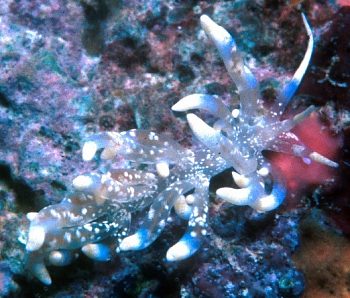
Phyllodesmium sp. 8
Order: NUDIBRANCHIA
Suborder: AEOLIDINA
Family: Glaucidae
PHOTO
measured about 18mm in length and was photographed at Enewetak Atoll, Marshall Islands in June, 1983. Photo: Scott Johnson
Authorship detailsRudman, W.B., 2002 (September 9) Phyllodesmium sp. 8 [In] Sea Slug Forum. Australian Museum, Sydney. Available from http://www.seaslugforum.net/find/phyllodsp8
Related messages
Phyllodesmium sp. from Hawaii [2]
July 3, 2007
From: Cory Pittman
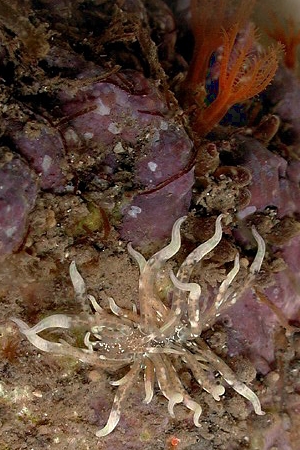
Dear Bill,
Here are the two additional photos to go with my previous message [#19720 ].
The upper photo is of an animal feeding on the stolon of it's host octocoral. It's relatively pale in the photo since it had been starved for a few days but it darkened markedly over the next few hours after the octocoral was introduced and was observed feeding on it intermittently over the next several days. It was collected on 12 April, 2002.
The lower photo shows a pair of egg masses on the underside of a cobble. They were laid by an animal collected on 12 May, 2002 and are 5 mm to 6 mm in diameter, typical for the species. The eggs hatch in about four days in the laboratory.
Locality: Hekili Point, Maui, intertidal to less than 1 m, Hawaii, USA, Pacific, 12 May 2002, protected to semi-protected cobble beaches. Length: 15 mm to 20 mm. Photographer: Cory Pittman.
Cory
cory@cet.com
Pittman, C. C., 2007 (Jul 3) Phyllodesmium sp. from Hawaii [2]. [Message in] Sea Slug Forum. Australian Museum, Sydney. Available from http://www.seaslugforum.net/find/19721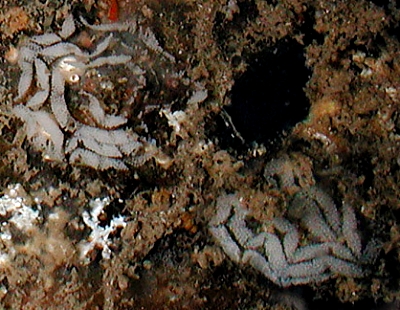
Thanks Cory,
I wish we had this much background information on every animal we posted on the Forum
Best wishes,
Bill Rudman
Phyllodesmium sp. from Hawaii [1]
July 3, 2007
From: Cory Pittman
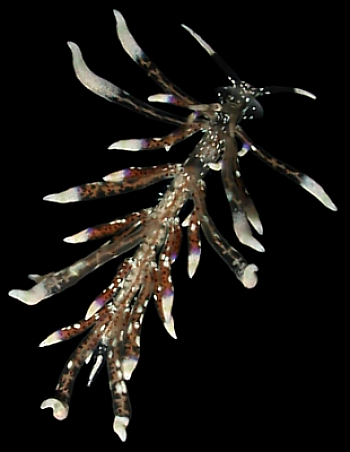
Dear Bill,
I thought you might be interested in some info on this Hawaiian Phyllodesmium sp. I suspect that it's the same as "Phyllodesmium sp. 8" and, perhaps, "Phyllodesmium sp. 10," as well.
I first noticed the species in 1983 at Hekili Point, Maui. Since then, I've seen some 40 animals (specimens deposited with Terry Gosliner at CAS). All were found in the low intertidal or very shallow subtidal on protected to semi-protected cobble beaches where it is closely associated with a small, unidentified octocoral (currently under study by Phill Alderslade, Sam Kahng, & Gary Williams). I've observed it feeding on that species in the laboratory where it appears to prefer the stolons and closed polyps.
It's nocturnally active (I've seen them crawling in the open at night and it shows a nocturnal pattern in dishes). However, during the day it can often be found resting near patches of its host octocoral on the undersides of cobbles, frequently in pairs. The largest specimen I've seen was 25 mm in length.
It has an extremely slender body and long cerata. The cerata usually appear straight when the animal is crawling or feeding at night but display "corkscrew" tips when slightly contracted in response to disturbance. The rhinophores are simple. The translucent-cream body and cerata are decorated with white blotches and the cerata have white tips. The digestive gland has short side branches that are usually dark brown giving the cerata and body a brown-speckled appearance. A touch of blue iridescence is often noticeable subapically on the cerata.
Both the octocoral and the Phyllodesmium seem unusual in that they appear to be largely restricted to the intertidal. The octocoral is zooxanthellate and retracts it's polyps at night. However, it grows exclusively on the undersides of cobbles, occupying a narrow band between the sponge-dominated community on their lower surfaces and the algae-dominated community on their upper surfaces. So, although its habitat is very sunny, it's actually a "twilight dweller" living in a heavily shaded micro-habitat and, presumably, containing zooxanthellae adapted for low light intensity. As mentioned, above, the Phyllodesmium feeds at night and rests near it's host during the day where it's exposed to similar lighting and, judging by their noticeably darker color, it also appears to concentrate its host's xooxanthellae in the small side branches of its digestive gland. That suggests that it may be getting at least some nutrition from them. This speculation might also be supported by the fact that its digestive gland is more elaborate than in most nocturnal Phyllodesmium spp though less elaborate than in most species that rest in the open during the day.
Another interesting behavior is its ability to conceal itself in remarkably small crevices. It often "disappears" rapidly when cobbles are overturned and a 17 mm animal collected in September 1988 and held for several days with a small basalt cobble that had visible holes no larger than 2 mm in diameter managed to repeatedly get completely out of sight during the day and "reappear" at dusk. Perhaps, this allows it to avoid dehydration during low tide?
The attached photos are all of animals collected from the low intertidal or very shallow subtidal at Hekili Point, Maui. I didn't record the length of the animals but I believe they were all in the 15 mm to 20 mm range.
Locality: Hekili Point, Maui, intertidal to less than 1 m, Hawaii, USA, Pacific, 12 May 2002, protected to semi-protected cobble beaches. Length: 15 mm to 20 mm. Photographer: Cory Pittman.
The middle left photo shows an animal resting on the underside of a cobble. It was collected on 12 May, 2002. The upper and middle right photos are of an animal collected on 07 May, 2004. They show the cerata in a more relaxed posture and a close-up of the color pattern and digestive gland.
The fifth photo is a shot of it's host octocoral growing on the underside of a cobble. It was taken on 19 August, 2001. The polyps are emerging from beneath a thin encrusting layer of blue sponge (Suberites sp.) and coralline algae.
Two other photos of it feeding and its eggs are in a second message [#19721 ]
Best wishes,
Cory
cory@cet.com
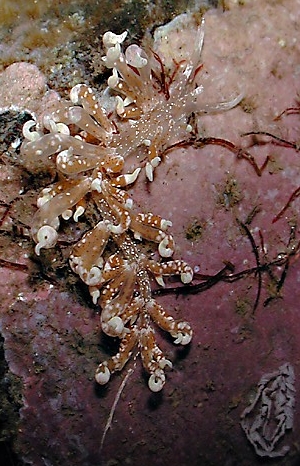
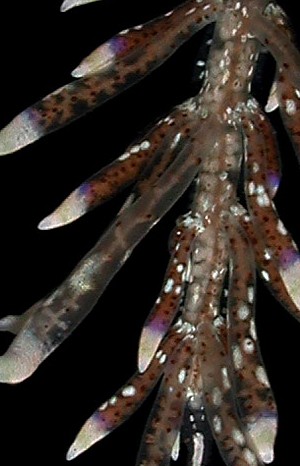
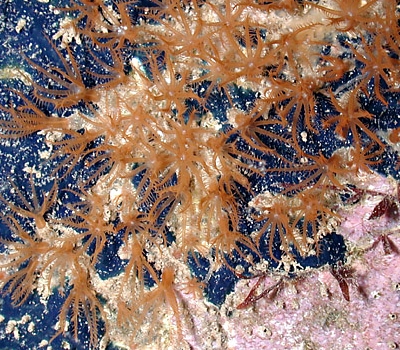
Dear Cory,
Thanks for all the background information on this species. It seems that at a certain stage in the evolution of this genus, the development of lateral branches off the central digestive gland duct in each ceras proved to be a good idea.We certainly find it in species, such as P. poindimiei and P. serratum, without any relationship with zooxanthellae or 'solar power'. Perhaps your species is an intermediate step. It is puzzling that even with zooxanthellae, bit the aeolid and the soft coral tend to shun sunlight. Perhaps what they are doing is shunning 'overbright' sunlight which might damage the photosynthetic factories of the zooxanthellae.
It is interesting that we now have three or for species with curled cerata. This genus still has many secrets to unfold.
Best wishes,
Bill Rudman
Phyllodesmium from the Marshall Islands
September 11, 2002
From: Scott Johnson

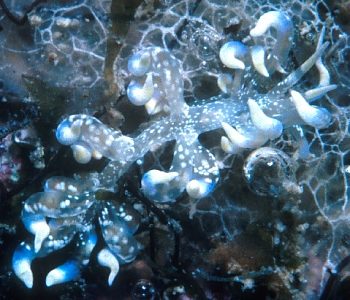
Hi Bill,
Here is another Phyllodesmium for the list. In color, it is very close to the Marshall Islands Phyllodesmium magnum (sent separately), but has much less inflated cerata. This specimen, the only one I've seen like this, measured about 18mm in length and was photographed at Enewetak Atoll, Marshall Islands in June, 1983. Its color pattern is also reminiscent of both Phyllodesmium macphersonae and Phyllodesmium sp. 6 on the Forum, but not quite similar enough for me to think it's the same as either.
By the way, while comparing my pics to images on the Forum, I found I could not get into Phyllodesmium sp. 7. Perhaps the link is broken.
Scott.
johnson@kmr.ll.mit.edu
Johnson, S., 2002 (Sep 11) Phyllodesmium from the Marshall Islands. [Message in] Sea Slug Forum. Australian Museum, Sydney. Available from http://www.seaslugforum.net/find/7844Thanks Scott,
I can only agree with your suggestion. It has similarities and differences to a number of species. For want of a more exciting alternative I'll call it Phyllodesmium sp. 8.
Thanks for drawing my attention to the link to Phyllodesmium sp. 7. I can't blame it on technology - it was entirely my fault. I was trying to get some consistency into filenames and failed in this case. If anyone has a private link to that page I have chaged the filename. If anyone finds links that don't work please let me know. We run checks regularly but sometimes they escape us.
Best wishes,
Bill Rudman
